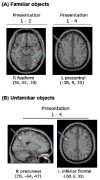Neural mechanisms of repetition priming of familiar and globally unfamiliar visual objects
- PMID: 20450898
- PMCID: PMC2922055
- DOI: 10.1016/j.brainres.2010.04.071
Neural mechanisms of repetition priming of familiar and globally unfamiliar visual objects
Abstract
Functional magnetic resonance imaging (fMRI) studies have shown that repetition priming of visual objects is typically accompanied by a reduction in activity for repeated compared to new stimuli (repetition suppression). However, the spatial distribution and direction (suppression vs. enhancement) of neural repetition effects can depend on the pre-experimental familiarity of stimuli. The first goal of this study was to further probe the link between repetition priming and repetition suppression/enhancement for visual objects and how this link is affected by stimulus familiarity. A second goal was to examine whether priming of familiar and unfamiliar objects following a single stimulus repetition is supported by the same processes as priming following multiple repetitions within the same task. In this endeavor, we examined both between and within-subject correlations between priming and fMRI repetition effects for familiar and globally unfamiliar visual objects during the first and third repetitions of the stimuli. We included reaction time of individual trials as a linear regressor to identify brain regions whose repetition effects varied with response facilitation on a trial-by-trial basis. The results showed that repetition suppression in bilateral fusiform gyrus, was selectively correlated with priming of familiar objects that had been repeated once, likely reflecting facilitated perceptual processing or the sharpening of perceptual representations. Priming during the third repetition was correlated with repetition suppression in prefrontal and parietal areas for both familiar and unfamiliar stimuli, possibly reflecting a shift from top-down controlled to more automatic processing that occurs for both item types.
Copyright (c) 2010 Elsevier B.V. All rights reserved.
Figures





Similar articles
-
Neural Correlates of Repetition Priming: A Coordinate-Based Meta-Analysis of fMRI Studies.Front Hum Neurosci. 2020 Sep 18;14:565114. doi: 10.3389/fnhum.2020.565114. eCollection 2020. Front Hum Neurosci. 2020. PMID: 33192395 Free PMC article.
-
Global familiarity of visual stimuli affects repetition-related neural plasticity but not repetition priming.Neuroimage. 2008 Jan 1;39(1):515-26. doi: 10.1016/j.neuroimage.2007.08.011. Epub 2007 Aug 23. Neuroimage. 2008. PMID: 17913513 Free PMC article.
-
Object identification leads to a conceptual broadening of object representations in lateral prefrontal cortex.Neuropsychologia. 2015 Sep;76:62-78. doi: 10.1016/j.neuropsychologia.2014.10.041. Epub 2014 Nov 7. Neuropsychologia. 2015. PMID: 25445775 Free PMC article.
-
Identifying task-general effects of stimulus familiarity in the parietal memory network.Neuropsychologia. 2019 Feb 18;124:31-43. doi: 10.1016/j.neuropsychologia.2018.12.023. Epub 2019 Jan 2. Neuropsychologia. 2019. PMID: 30610842 Free PMC article.
-
Repetition suppression to faces in the fusiform face area: A personal and dynamic journey.Cortex. 2016 Jul;80:174-84. doi: 10.1016/j.cortex.2015.09.012. Epub 2015 Oct 31. Cortex. 2016. PMID: 26615518 Review.
Cited by
-
Neural Correlates of Repetition Priming: A Coordinate-Based Meta-Analysis of fMRI Studies.Front Hum Neurosci. 2020 Sep 18;14:565114. doi: 10.3389/fnhum.2020.565114. eCollection 2020. Front Hum Neurosci. 2020. PMID: 33192395 Free PMC article.
-
Event-related brain potentials that distinguish false memory for events that occurred only seconds in the past.Behav Brain Funct. 2012 Jul 30;8:36. doi: 10.1186/1744-9081-8-36. Behav Brain Funct. 2012. PMID: 22846189 Free PMC article.
-
Electrophysiological correlates of object-repetition effects: sLORETA imaging with 64-channel EEG and individual MRI.BMC Neurosci. 2012 Oct 17;13:124. doi: 10.1186/1471-2202-13-124. BMC Neurosci. 2012. PMID: 23075055 Free PMC article.
-
Repetition enhancement and perceptual processing of visual word form.Front Hum Neurosci. 2012 Jul 12;6:206. doi: 10.3389/fnhum.2012.00206. eCollection 2012. Front Hum Neurosci. 2012. PMID: 22807895 Free PMC article.
-
Orienting and memory to unexpected and/or unfamiliar visual events in children and adults.Dev Cogn Neurosci. 2019 Apr;36:100615. doi: 10.1016/j.dcn.2019.100615. Epub 2019 Jan 16. Dev Cogn Neurosci. 2019. PMID: 30685577 Free PMC article.
References
-
- Bergerbest D, Ghahremani DG, Gabrieli JD. Neural correlates of auditory repetition priming: reduced fMRI activation in the auditory cortex. J Cogn Neurosci. 2004;16(6):966–977. - PubMed
-
- Bunzeck N, Schutze H, Duzel E. Category-specific organization of prefrontal response-facilitation during priming. Neuropsychologia. 2006;44(10):1765–1776. - PubMed
-
- Collette F, Hogge M, Salmon E, Van der Linden M. Exploration of the neural substrates of executive functioning by functional neuroimaging. Neuroscience. 2006;139(1):209–221. - PubMed
-
- Daselaar SM, Veltman DJ, Rombouts SA, Raaijmakers JG, Jonker C. Aging affects both perceptual and lexical/semantic components of word stem priming: An event-related fMRI study. Neurobiol Learn Mem. 2005;83(3):251–262. - PubMed
Publication types
MeSH terms
Grants and funding
LinkOut - more resources
Full Text Sources

